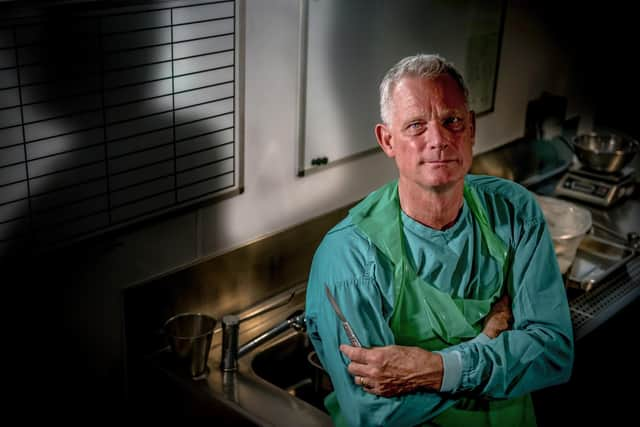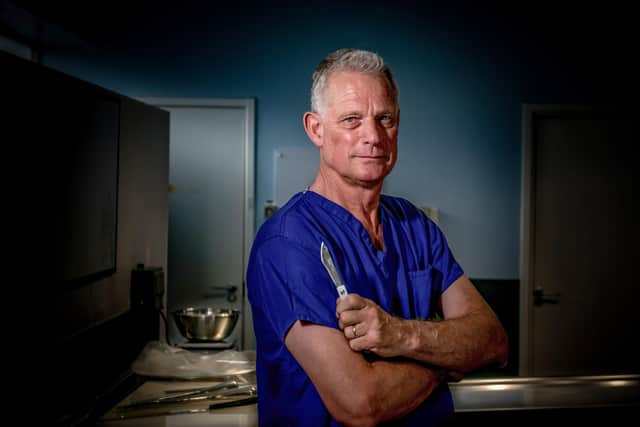Meet retired top forensic pathologist whose cases have included Princess Diana and victims of 9/11 and London bombings
His expertise has convicted murderers and acquitted the innocent. He has shone light on massacres and tragedies. And he has helped parents who lost children come to terms with their grief by being able to explain what happened.
Dr Shepherd became a best-selling author with a critically-acclaimed book about the realities of dealing with sudden and often violent death – and the personal toll that took, as he suffered a breakdown when flashbacks of what he had witnessed left him suicidal.
Advertisement
Hide AdAdvertisement
Hide AdNow he is giving an insight into the work of the forensic pathologist with a stage show, Unnatural Causes – also the title of his best-seller – which is coming to York and Leeds next month, inviting its audiences to interact with the trail that leads from autopsy to a defendant going on trial for murder.


And before then, Dr Shepherd presents a new television series, The Truth About My Murder, exploring a series of notorious killings and the science that led to murderers being caught.
His is a world fictionalised in the long-running BBC drama Silent Witness, and for Dr Shepherd, 69, public fascination with pathology’s detective work which attracts millions of viewers to the programme is mirrored in his audiences.
He said: “The way I approach it is to try to tell the tale of a particular case that I was involved with, so I talk about what happened, how the police responded and my autopsy. I talk about what I would do, and the things I’m going to be particularly interested in and I talk a little bit about why I became interested in forensic pathology and why post mortems are important.
Advertisement
Hide AdAdvertisement
Hide Ad“I talk about what’s it’s like to give evidence in court and then I get the audience to vote. They have to be the jury and it’s absolutely fascinating. The same information is presented to 500 people and the way the audience splits is quite amazing. And during the question and answer session, we always get the question, ‘What’s the best way to murder someone’?”


Dr Shepherd’s own story is as compelling as the stories he has probed in his career.
His mother died when he was only nine, sparking a desire to understand death better. After training as a doctor in his native London, he qualified as a pathologist in 1987 and joined the elite forensic department at Guy’s Hospital, embarking on a career that involved him investigating some of the most disturbing mass deaths of the past 40 years.
First came the Hungerford massacre of 1987, when gun-obsessed loner Michael Ryan shot 16 people, including a police officer and his own mother, before killing himself. Then there was the sinking of the Marchioness pleasure boat on the Thames in 1989, in which 51 people drowned, 9/11, the terrorist bombing of a Bali nightclub in 2002 which killed 202 people and the July 7 2005 London bombings in which 52 died.
Advertisement
Hide AdAdvertisement
Hide AdDr Shepherd believed he could cope with the horrors he had witnessed. Then one day when he was in his early 60s and at the peak of his career, they overwhelmed him and he suffered a breakdown.
“I talk about it like a trapdoor opening. In retrospect, maybe there were signs that I had not detected, but it was one afternoon, suddenly all of these memories appeared and wouldn’t go away and it was a very, very acutely shocking and scary time.
“They came from nowhere, and I remember I was sitting in my office and I just couldn’t push these memories away. They were just there constantly and it was very, very scary to have that sense of losing control when I always felt I was in control of that aspect of my work, able to manage it and deal with it. Suddenly I was confronted with the truth that I couldn’t manage that.”
He tried to avoid blinking, because even in that split-second of his eyes closing, he had flashbacks. The sound of ice clinking in a glass took him back to Bali and the ice-packs piled on the bodies of bombing victims to preserve them in the sweltering heat. Instead of carving the Sunday roast at home, Dr Shepherd found himself stabbing it.
Advertisement
Hide AdAdvertisement
Hide AdHis wife, Linda, also a doctor, insisted he seek urgent help. “As quickly as it had come it needed dealing with, because she and the people looking after me were seriously concerned that I might kill myself, and certainly I had those thoughts but fortunately they didn’t go anywhere.
“Apart from the ups and down of life that we all have, I think I’ve been a very positive, upbeat, active person so I think this was why it was more of a shock to find myself incapable of deciding if I wanted a cup of tea or moving anywhere. It really was such a change, and coming as it did hit me like a train.”
He was prescribed anti-anxiety medication and underwent psychotherapy, which got him over the crisis.
“I can look at the images, I can think about them, but I have the confidence now to put them away again and get on with my life as it is. But it did put down a marker to remind me I was getting on a bit and retirement was coming.”
Advertisement
Hide AdAdvertisement
Hide AdDr Shepherd, who lives in Cheshire, no longer carries out on-call forensic pathology that would plunge him into crime scenes, but still acts as an expert witness.
Stepping back gave him time to reflect and write Unnatural Causes. “It had been bubbling away for a good while. When I retired it gave me the time and the space to do the writing and that was quite nicely cathartic as well, to go through those cases. It added to the recovery because I felt secure and safe to go there.”
Some cases stay with him especially vividly. One is Princess Diana’s death in the Paris car crash of August 1997.
“Forensically, it was fascinating to be involved in that process. I can’t say it was just another road accident. I’ve seen so many of those my career, and noticed the change when seatbelts became compulsory. It’s always been my view that Diana died because she wasn’t wearing a seatbelt. Had she had one on, maybe she wouldn’t have been uninjured, but I don’t think she would have died.”
Advertisement
Hide AdAdvertisement
Hide AdAnother is the sudden death of a young girl with epilepsy. “That’s a case that has always stayed with me. Talking to her family, seeing their abject trauma and distress of coming to terms with it, but also how important it was for them to have an understanding, to be able to see that they had done nothing wrong, that there was nothing they could have changed, so they could move forward.
“Cases like that, unknown to anyone else, leave a mark. I do hope with that family, and with many others, in the depths of utter awfulness I have been able to make a bit of a positive contribution to the start of their grieving.”
Dr Richard Shepherd will present Unnatural Causes at York Theatre Royal on October 13. Further details and booking at yorktheatreroyal.co.uk/show/doctor-richard-shepherd-unnatural-causes/
On October 14, the show will be at Leeds City Varieties. Further details and booking at leedsheritagetheatres.com/whats-on/dr-richard-shepherd/
The Truth About My Murder begins on CBS Reality on September 21 and is a 10-part series.